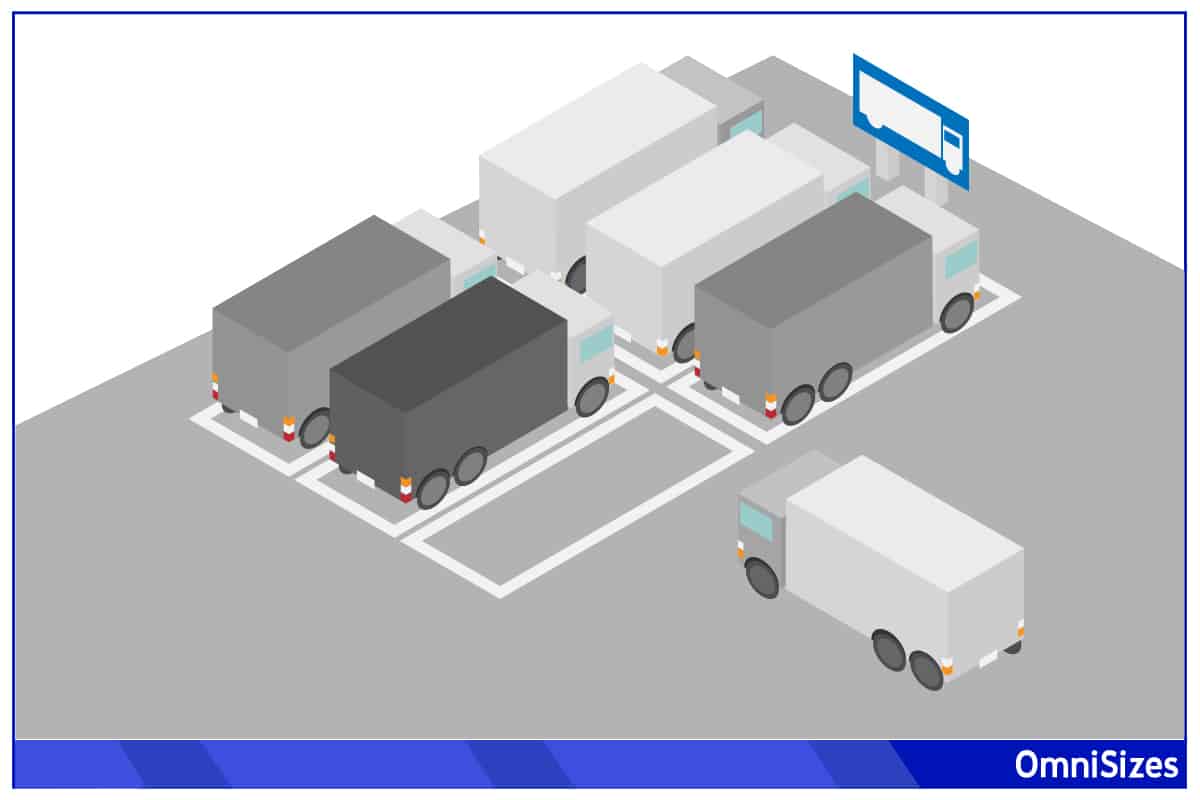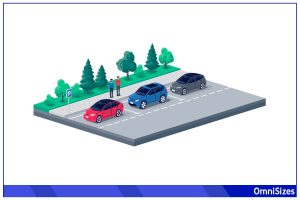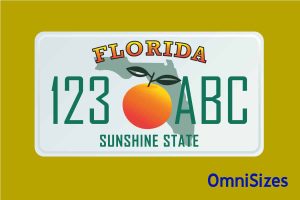Trucking is about hitting the open road and finding a place for these giant vehicles to rest. Trucking space sizes are a big deal, literally. They dictate everything from driver rest periods to local traffic patterns.
The typical truck parking space measures around 12 feet wide (3.7 m) and 40 feet long (12.2 m). The exact measurements depend on what is parked. For instance, semi-trucks with trailers may need as much as 12 × 100 feet (3.7 × 30.5 m) of parking space, while the semi-trailer alone requires just 12 × 55 feet (3.7 × 16.8 m) to park.
Buckle up because that’s not all there is to know about truck space sizes! This guide will explain the basic of truck parking spaces and the various aspects of designing a truck parking space.
Basics of Truck Parking
If you thought parallel parking a sedan was difficult, you’ve probably never tried parking a truck. It’s all about fitting big rigs between the lines, but it begins with the size of the parking space.
Truck Parking Space Dimensions
Truck parking isn’t a one-size-fits-all deal. Standard parking spots usually stretch out to about 15 feet wide and 40 feet long. But here’s the twist: different trucks need different spaces. A standard semi-truck might cozy up in these dimensions, but add a trailer, and it’s a whole new game.
Plus, some spots are angled or straight, which affects how a truck slides in.
| Parking Orientation | Parking Space Width | Parking Space Length | Distance Between Adjacent Parking Spots |
| Parallel | 12 ft. | 100 ft. | N/A |
| 30° | 11 ft. | 40-75 ft. | 23 ft. |
| 45° | 11 ft. | 40-75 ft. | 31 ft. |
| 60° | 11 ft. | 40-75 ft. | 36 ft. |
| 90° | 11 ft. | 40-75 ft. | 39 ft. |
Types of Trucks and Corresponding Parking Needs
From the hulking long-haul semi-trucks to the more modest-sized delivery trucks, each has its own parking persona.
For instance, semi-trucks with their trailers typically measure around 8.5 × 72 feet. As you can see from the table above, many designated parking spots for trucks provide a wide clearance on both sides, with plenty of room to spare in front and behind the vehicle.
On the flip side, box trucks, measuring up to 8.5 × 22.5 feet, don’t need nearly as much space. In fact, many of them can park in spaces designed for the average passenger vehicle.
Truck Parking Space Design Considerations
Designing truck parking requires balancing space, safety, and efficiency. Of course, there’s a ton more technical aspects to consider.
1. Planning for Different Truck Sizes and Types
As described above, different truck types have different parking requirements. Before paving bare land, make sure you know what type of truck is going to seek refuge on your lot. Semi-trucks are giants that take up much more square footage than the typical cargo van or box truck, so plan accordingly.
2. Height Considerations for Loading Docks
If a fleet of semis is going to unload cargo from several states over, you better prepare your dock for smooth unloading. Most trailers are designed to load and unload at a height of 48 to 52 inches, but specific truck types fall below or even above this range.
3. Safety Considerations in Truck Parking Design
A truck parking lot shouldn’t feel like an obstacle course. Safety is paramount. This means clear lanes for driving and walking, ample lighting, and signs that are easy to read. Parking spaces should be designed so trucks can easily enter and exit without the risk of collisions.
Road Surface for Truck Parking Spaces

Truck parking spaces need a stage that can handle the weight and wear of these big rigs. Here’s what you need to know about road surface options that keep these heavy haulers parked just right.
1. Concrete
Concrete is the heavyweight champion of road surfaces. It’s durable, long-lasting, and can handle the heaviest of trucks without batting an eye. While it might cost more upfront, concrete’s long life makes it a smart investment for heavy-use areas.
2. Asphalt
Asphalt is more flexible than concrete, which can be a plus in areas with temperature swings. Less expensive and quicker to lay down than concrete, asphalt is budget-friendly but might need more frequent touch-ups.
3. Permeable Pavements
Permeable pavements can help lower surface temperatures, making the parking area cooler. These surfaces let water seep through, reducing runoff and recharging the groundwater. Compared to traditional concrete and asphalt, you’re most likely looking at a steeper price point, but it’s an investment that can pay for itself.
4. Reinforced Grass
For a more natural look, reinforced grass pavements use a grid system to support the weight of trucks, while allowing grass to grow. This option reduces heat and offers a more environmentally friendly choice compared to traditional surfaces.
5. Gravel
Gravel is a budget-friendly option, especially in rural or less frequently used areas. While good for drainage, it requires regular maintenance to stay in tip-top shape, especially when something as heavy as a semi is involved.
Parking Requirements for Hazardous Material Trucks

Trucks loaded with hazardous materials (hazmat) come with their own set of parking rules. There are particular rules in place to keep everyone and everything safe.
1. Designated Spots
Hazmat trucks are often required to park in designated areas that are isolated from general traffic and pedestrian areas. This separation reduces the risk of accidents involving other vehicles or people. These designated areas are also strategically located for easy access by emergency response teams in case of an incident.
2. Safety Features
- Spill Containment: Parking spaces for hazmat trucks may include spill containment features, such as barriers or drainage systems, to control and contain any accidental leaks.
- Fire Safety: Enhanced fire safety measures, like proximity to fire extinguishers or water sources, are also crucial.
- Surveillance: Constant monitoring, either by security personnel or through surveillance cameras, helps in ensuring the safety and security of the parked hazmat trucks.
- Lighting: Adequate lighting is essential for visibility and security, especially during nighttime.
3. Regulatory Compliance
- Signage: Clear and prominent signage indicating the nature of the materials and the special parking requirements is mandatory.
- Documentation: Drivers are often required to have proper documentation readily available, including material safety data sheets and emergency response information.






